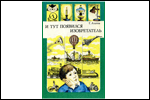
|
|
BOOKS AND ARTICLES
SOMETHING ABOUT SYSTEMS
Books and articles / And then came the inventor
If the amoeba had the gift of speech, it could say: “My ancestors, single-celled, lived on Earth billions of years ago. And now everything consists of cells. A tree is a union of cells. Humans too. This means that the era of cells continues!” With all due respect to the single-celled interlocutor, we would have to object: “A tree and a person have properties that cells do not possess. A tree and a person are a system of cells. So on Earth it is not an era of cells, but an era of systems...” Development through education and complication of systems is a universal law. In technology, development also goes from “cells” to systems. A locomotive is a “cage”, railway transport is a system. A telephone set is a “cage”, a telephone network is a system. Once in the system, the “cell” works more efficiently and develops quickly. But it depends on the system and cannot exist without it. Modern technology is a technology of systems. Its “cells” - various devices, devices, machines - do not work on their own, but in combination. Therefore, the second half of the XNUMXth century is increasingly called the century of technical systems. The order in the age of technical systems is feudal. Remember what it was like in the Middle Ages? A vassal was subordinate to a lord, who in turn was a vassal to a larger lord, etc. The same hierarchy reigns in the world of technical systems. An electric lamp is the “vassal” of the lighting system in a car. But the lighting system has its own “senior” - the electrical equipment system, which is also part of a “superior” system called “car”. And Senor Automobile is a “vassal” of a large system of Motor Transport, which includes millions of cars, a gigantic network of roads, gas stations, and repair shops. Each technical system has a “senior” - a supersystem. And their “vassals” - subsystems. Any change in the system affects subsystems and supersystems. Technical contradictions arise because someone forgets about this: one of the “vassals” suddenly gains advantages at the expense of the other or at the expense of the “lord”. Therefore, it is necessary to take into account not only the “interests” of the system given in the conditions of the problem, but also the “interests” of the over-system and subsystems. Let's take a specific task and see how “feudal interests” should be taken into account. Problem 19. WE CAN DO WITHOUT TELEPATHY
One day a brand new Volga stopped on the highway. The driver confusedly explained to the passenger: - That's the trouble, gasoline ran out. I forgot, you know, to look at the device. “It happens,” the passenger responded sympathetically. - Yes, and these devices are unreliable. Sometimes the needle is still far from zero, but the tank is empty. Now, if the tank telepathically conveyed to the driver that gasoline was running low... And then an inventor appeared. "We can do without telepathy," he said. - I have an idea... What did the inventor suggest? Let's start with the analysis. Supersystem car. Our proposal should not affect the “interests” of the car. And the “interest” of the car is simple: so that there are no alterations. This is a typical “interest” for all supersystems, if the task is not related to their radical restructuring or replacement. Let's take this "interest" into account. Subsystems also have “interests”. The alarm system includes four subsystems: gasoline, the gas tank, what “signals” (the “X” that needs to be found), and the driver’s head. Well, let’s immediately leave the head alone: any idea that requires at least a minimal “rework” of the head will obviously not work. Gasoline can also be ignored. Let's consider the limiting case: there is no gasoline (or almost no) - and then a signal appears. Two subsystems remain: “X” and the gas tank. The gas tank has a simple “interest”: so that it is not changed, rebuilt, or altered. It turns out that “x” should be almost equal to zero. Otherwise, you will have to redo either the gasoline or the car. For example, “X” cannot possibly be an X-ray machine: this would mean an unacceptable complication of the car. Now the requirements for subsystems, the system and the supersystem have become so clear that it is possible to determine “x” with mathematical accuracy. A little later I will show how this is done. In the meantime, think for yourself. An empty tank (or almost empty) should create a signal in the driver's head. When there is gasoline in the tank, there should be no signal. And a certain “X” should help in this, so small that neither the car (supersystem) nor gasoline (subsystem) will practically change from the introduction of this “X”.
Machine for thinning flowers in gardens
02.05.2024 Advanced Infrared Microscope
02.05.2024 Air trap for insects
01.05.2024
▪ Iron transparent to gamma radiation ▪ Don't hesitate to become a father ▪ TRACO THN/WIR DC/DC Converters for Harsh Environments ▪ Dual core controllers for the automotive industry
▪ section of the site Consumer Electronics. Selection of articles ▪ article Occupational noise and its impact on humans. Basics of safe life ▪ article Engine waddling. Children's Science Lab ▪ Prostokvash article. Simple recipes and tips
Home page | Library | Articles | Website map | Site Reviews www.diagram.com.ua |






 Arabic
Arabic Bengali
Bengali Chinese
Chinese English
English French
French German
German Hebrew
Hebrew Hindi
Hindi Italian
Italian Japanese
Japanese Korean
Korean Malay
Malay Polish
Polish Portuguese
Portuguese Spanish
Spanish Turkish
Turkish Ukrainian
Ukrainian Vietnamese
Vietnamese



 See other articles Section
See other articles Section 